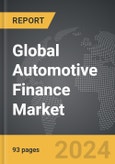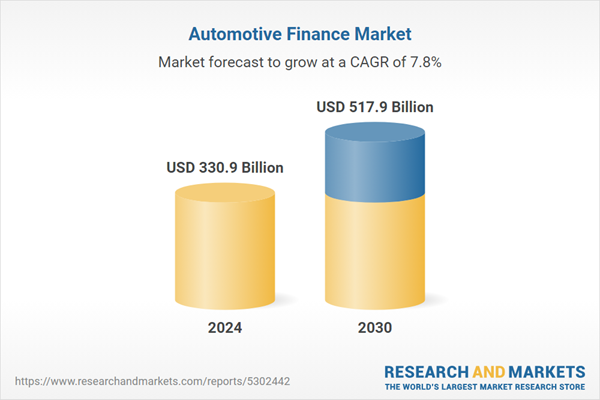The global market for Automotive Finance was valued at US$330.9 Billion in 2024 and is projected to reach US$517.9 Billion by 2030, growing at a CAGR of 7.8% from 2024 to 2030. This comprehensive report provides an in-depth analysis of market trends, drivers, and forecasts, helping you make informed business decisions. The report includes the most recent global tariff developments and how they impact the Automotive Finance market.
Segments: Provider Type (Banks, OEM, Other Provider Types); Finance Type (Direct, Indirect); Purpose Type (Loan, Leasing, Other Purpose Types); End-Use (Passenger Cars, Commercial Vehicles).
Geographic Regions/Countries: World; United States; Canada; Japan; China; Europe (France; Germany; Italy; United Kingdom; Spain; Russia; and Rest of Europe); Asia-Pacific (Australia; India; South Korea; and Rest of Asia-Pacific); Latin America (Argentina; Brazil; Mexico; and Rest of Latin America); Middle East (Iran; Israel; Saudi Arabia; United Arab Emirates; and Rest of Middle East); and Africa.
The analysts continuously track trade developments worldwide, drawing insights from leading global economists and over 200 industry and policy institutions, including think tanks, trade organizations, and national economic advisory bodies. This intelligence is integrated into forecasting models to provide timely, data-driven analysis of emerging risks and opportunities.
Global Automotive Finance Market - Key Trends and Drivers Summarized
Why Is Automotive Finance Essential for the Modern Car Market?
Automotive finance has become a vital component of the automotive industry, enabling consumers and businesses alike to access vehicles through flexible financial solutions. For consumers, automotive finance options such as loans, leasing, and hire purchase agreements allow for vehicle ownership without the substantial upfront costs, making cars more accessible across various income levels. The financial flexibility provided by these options has expanded vehicle ownership, as customers can choose financing plans that suit their budget and lifestyle. For businesses, automotive finance is an effective way to manage fleets without the financial burden of outright purchase, supporting operational needs while maintaining cash flow. This accessibility extends to a range of vehicles, from entry-level sedans to luxury models and electric vehicles (EVs), allowing consumers to adopt newer technologies without a large initial investment. As the automotive landscape shifts towards electric and autonomous vehicles, automotive finance continues to play a crucial role in bridging the gap between technological advancement and consumer adoption, supporting the industry’s evolution by making cutting-edge vehicles financially feasible for a broader audience.How Are Digital Innovations Transforming the Automotive Finance Landscape?
Digital innovations are reshaping the automotive finance landscape, making the process of securing a vehicle faster, more transparent, and highly personalized. With advancements in fintech and digital platforms, the automotive finance sector has seen the rise of online marketplaces, mobile applications, and digital lending platforms that simplify the entire financing process, from application to approval. These platforms use data analytics, machine learning, and AI to assess creditworthiness instantly, enabling consumers to get pre-approved for financing within minutes and reducing traditional paperwork. Additionally, online financing calculators and comparison tools provide transparency, allowing customers to explore various financing options, compare rates, and understand their financial commitments before making a decision. Digital platforms have also enhanced customer experience by enabling seamless integration with dealerships, where buyers can complete financing paperwork digitally, often at the dealership or from home. The introduction of blockchain technology for secure digital transactions and automated loan management further contributes to streamlined processes and enhanced security. These digital solutions not only improve accessibility and efficiency but also provide tailored financing options, making automotive finance more responsive to individual needs and preferences in a tech-savvy marketplace.What Role Does Automotive Finance Play in the Shift Toward Electric and Autonomous Vehicles?
Automotive finance is playing an increasingly critical role in the transition to electric and autonomous vehicles by enabling consumers to adopt these emerging technologies through flexible payment options. Electric vehicles (EVs) and autonomous features often come with higher price tags due to the cost of advanced batteries, sensors, and software systems, making financing options essential for broader adoption. Finance providers have responded by introducing tailored packages and incentives specific to EVs, such as lower interest rates, longer loan terms, and lease agreements that allow users to upgrade to newer technology as it becomes available. Furthermore, as EV infrastructure grows, automotive finance is increasingly incorporating value-added services, like subscription-based plans covering charging, maintenance, and insurance, to make EV ownership more convenient and cost-effective. For autonomous vehicles, which may initially see adoption within commercial fleets, financing options such as operational leases and subscription models enable businesses to test and incorporate these technologies without large capital expenditures. Additionally, government incentives and rebates for EV purchases can be incorporated into financing arrangements, helping lower the barrier to entry for eco-conscious consumers. By making advanced vehicles financially accessible, automotive finance is driving consumer engagement with sustainable and autonomous mobility solutions, supporting the automotive industry’s transition to a cleaner, smarter future.What Factors Are Driving the Growth in the Automotive Finance Market?
The growth in the automotive finance market is driven by several factors, rooted in changing consumer behavior, technological advancements, and economic trends. A key driver is the increasing consumer preference for flexible financing options, including leasing and subscription models, which allow access to a vehicle without long-term commitment, especially as technology rapidly evolves and consumers prioritize flexibility. Additionally, the shift toward digital finance solutions, accelerated by the COVID-19 pandemic, has created high demand for online and contactless financing options that provide convenience and speed. As consumers become more accustomed to digital experiences, automotive finance companies are responding by expanding their online platforms and services, enhancing the growth of digital automotive financing. The push for electric vehicles (EVs) and government incentives for low-emission vehicles are also significant growth drivers, as these factors encourage consumers to explore financing options that can integrate incentives or provide long-term affordability. Additionally, the rise of ride-sharing, car-sharing, and other alternative ownership models has led to the creation of innovative finance packages that cater to both short-term users and traditional buyers. Macroeconomic conditions, such as low-interest rates and increased availability of credit, further stimulate demand for automotive financing by making borrowing more affordable. Together, these factors are fueling the growth of the automotive finance market, enabling it to adapt to evolving consumer expectations and technological advancements in the automotive sector.Report Scope
The report analyzes the Automotive Finance market, presented in terms of units. The analysis covers the key segments and geographic regions outlined below.Segments: Provider Type (Banks, OEM, Other Provider Types); Finance Type (Direct, Indirect); Purpose Type (Loan, Leasing, Other Purpose Types); End-Use (Passenger Cars, Commercial Vehicles).
Geographic Regions/Countries: World; United States; Canada; Japan; China; Europe (France; Germany; Italy; United Kingdom; Spain; Russia; and Rest of Europe); Asia-Pacific (Australia; India; South Korea; and Rest of Asia-Pacific); Latin America (Argentina; Brazil; Mexico; and Rest of Latin America); Middle East (Iran; Israel; Saudi Arabia; United Arab Emirates; and Rest of Middle East); and Africa.
Key Insights:
- Market Growth: Understand the significant growth trajectory of the Banks segment, which is expected to reach US$284.2 Billion by 2030 with a CAGR of a 7.3%. The OEM segment is also set to grow at 8.5% CAGR over the analysis period.
- Regional Analysis: Gain insights into the U.S. market, valued at $86.5 Billion in 2024, and China, forecasted to grow at an impressive 11.0% CAGR to reach $120.4 Billion by 2030. Discover growth trends in other key regions, including Japan, Canada, Germany, and the Asia-Pacific.
Why You Should Buy This Report:
- Detailed Market Analysis: Access a thorough analysis of the Global Automotive Finance Market, covering all major geographic regions and market segments.
- Competitive Insights: Get an overview of the competitive landscape, including the market presence of major players across different geographies.
- Future Trends and Drivers: Understand the key trends and drivers shaping the future of the Global Automotive Finance Market.
- Actionable Insights: Benefit from actionable insights that can help you identify new revenue opportunities and make strategic business decisions.
Key Questions Answered:
- How is the Global Automotive Finance Market expected to evolve by 2030?
- What are the main drivers and restraints affecting the market?
- Which market segments will grow the most over the forecast period?
- How will market shares for different regions and segments change by 2030?
- Who are the leading players in the market, and what are their prospects?
Report Features:
- Comprehensive Market Data: Independent analysis of annual sales and market forecasts in US$ Million from 2024 to 2030.
- In-Depth Regional Analysis: Detailed insights into key markets, including the U.S., China, Japan, Canada, Europe, Asia-Pacific, Latin America, Middle East, and Africa.
- Company Profiles: Coverage of players such as Ally Financial, Bank of America, Capital One, Chase Auto Finance, Daimler Financial Services and more.
- Complimentary Updates: Receive free report updates for one year to keep you informed of the latest market developments.
Some of the 41 companies featured in this Automotive Finance market report include:
- Ally Financial
- Bank of America
- Capital One
- Chase Auto Finance
- Daimler Financial Services
- Ford Motor Credit Company
- GM Financial Inc.
- Hitachi Capital
- Toyota Financial Services
- Volkswagen Financial Services
Tariff Impact Analysis: Key Insights for 2025
Global tariff negotiations across 180+ countries are reshaping supply chains, costs, and competitiveness. This report reflects the latest developments as of April 2025 and incorporates forward-looking insights into the market outlook.The analysts continuously track trade developments worldwide, drawing insights from leading global economists and over 200 industry and policy institutions, including think tanks, trade organizations, and national economic advisory bodies. This intelligence is integrated into forecasting models to provide timely, data-driven analysis of emerging risks and opportunities.
What’s Included in This Edition:
- Tariff-adjusted market forecasts by region and segment
- Analysis of cost and supply chain implications by sourcing and trade exposure
- Strategic insights into geographic shifts
Buyers receive a free July 2025 update with:
- Finalized tariff impacts and new trade agreement effects
- Updated projections reflecting global sourcing and cost shifts
- Expanded country-specific coverage across the industry
Table of Contents
I. METHODOLOGYII. EXECUTIVE SUMMARY2. FOCUS ON SELECT PLAYERSIII. MARKET ANALYSISCANADAITALYSPAINRUSSIAREST OF EUROPESOUTH KOREAREST OF ASIA-PACIFICARGENTINABRAZILMEXICOREST OF LATIN AMERICAIRANISRAELSAUDI ARABIAUNITED ARAB EMIRATESREST OF MIDDLE EASTIV. COMPETITION
1. MARKET OVERVIEW
3. MARKET TRENDS & DRIVERS
4. GLOBAL MARKET PERSPECTIVE
UNITED STATES
JAPAN
CHINA
EUROPE
FRANCE
GERMANY
UNITED KINGDOM
ASIA-PACIFIC
AUSTRALIA
INDIA
LATIN AMERICA
MIDDLE EAST
AFRICA
Companies Mentioned (Partial List)
A selection of companies mentioned in this report includes, but is not limited to:
- Ally Financial
- Bank of America
- Capital One
- Chase Auto Finance
- Daimler Financial Services
- Ford Motor Credit Company
- GM Financial Inc.
- Hitachi Capital
- Toyota Financial Services
- Volkswagen Financial Services
Table Information
| Report Attribute | Details |
|---|---|
| No. of Pages | 93 |
| Published | April 2025 |
| Forecast Period | 2024 - 2030 |
| Estimated Market Value ( USD | $ 330.9 Billion |
| Forecasted Market Value ( USD | $ 517.9 Billion |
| Compound Annual Growth Rate | 7.8% |
| Regions Covered | Global |









